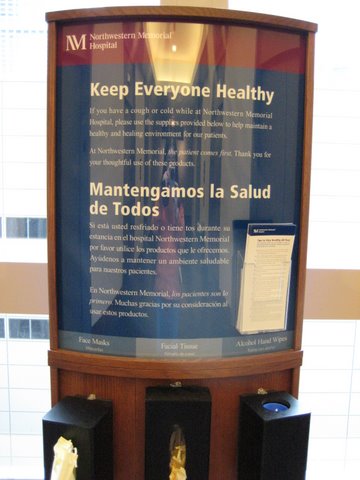I’ve spent the last few days in a hospital, while a family-member had surgery and has been recovering. This is a relatively new hospital, so it looks more like a nice hotel with its grand entry, “concierge-like” welcome desks, and comfortable furniture. (They also have a great Au Bon Pain that is open 24 hours!)

Healthy tools available at the bottom of the kiosks: Face Masks, Facial Tissues and Alcohol Handy Wipes
One of the first things I noticed in the waiting areas were the Keep Everyone Healthy kiosks (pictured at right.) These reminded me of an article I read a while back (Selling Soap) about how the risk of catching an infection IN a hospital is quite high, and that’s because the hospital staff doesn’t wash its hands enough. The article talked about Cedars-Sinai Hospital in LA that had a successful campaign to encourage hospital staff to wash their hands more.
I wondered whether these Keep Everyone Healthy kiosks were part of a larger push at the hospital to include everyone in the community. Certainly, I have been a part of the hospital community for the better part of the past week, and I appreciated having the tissues there in the waiting room. I saw some other folks go over and pick up a wipe or a tissue, too. Though I have yet to see any face mask takers.
I have no doubt that seeing the kiosks in the waiting area has influenced my thinking about the importance of sanitation within other parts of the hospital; namely the rooms where patients are recovering. There are signs all over the place that emphasize the importance of wearing gloves and washing hands before and after patient contact.
I haven’t been keeping an eagle eye on the staff, but I can say that norm is for doctors/nurses/technicians to either put on new gloves, wash their hands or use a sanitizing gel when they walk in the room, and throw out the gloves or wash their hands on the way out. It helps that each private room has a washing sink in the entry area, gloves are provided in three sizes, and there’s one sanitizing gel inside the door and another outside the door.
They have made it Simple and Easy to do this simple but effective community health safety step. In my short tenure at the hospital, it’s become a habit!
So taking this out of the hospital, I’d like to think about what steps I can take to make hand-hygiene more of a routine for me, whether I’m at home or outside. Some things come to mind:
- Make an effort to wash my hands before each meal–especially when I’m eating out–and after I’ve used public transport or have shaken a lot of hands. Also, after I get home from a day out. Do this enough, and it becomes a habit.
- Increase this if I think I am getting sick, or have a cold.
- Carry something like Purell hand sanitizer in my bag, as a backup.
Here’s a post from earlier about hand-washing, including a tip on how to know you’re washing long enough.
 I came across a short NPR piece called How to Keep Your Feet Happy, which talks about a common foot ailment, plantar fasciitis. It provides advice on the best kind of shoes to wear — they should have a minimum of support — and an audio slideshow with exercises to strengthen and stretch feet presented by podiatrist-turned-Pilates instructor Colleen Schwartz.
I came across a short NPR piece called How to Keep Your Feet Happy, which talks about a common foot ailment, plantar fasciitis. It provides advice on the best kind of shoes to wear — they should have a minimum of support — and an audio slideshow with exercises to strengthen and stretch feet presented by podiatrist-turned-Pilates instructor Colleen Schwartz.




